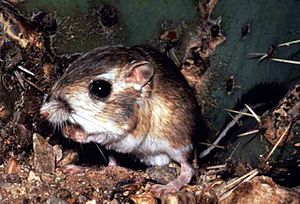Fresno kangaroo rat facts for kids
Quick facts for kids Fresno kangaroo rat |
|
|---|---|
 |
|
| Conservation status | |
| Scientific classification | |
| Genus: |
Dipodomys
|
| Species: |
nitratoides
|
The Fresno kangaroo rat or San Joaquin kangaroo rat (Dipodomys nitratoides) is a type of rodent in the Heteromyidae family. This small animal lives only in and around the San Joaquin Valley in California, United States. Sadly, its home is shrinking because of farms and cities. This means the International Union for Conservation of Nature says it is a "vulnerable" animal, meaning it's at risk of disappearing.
There are three types of Fresno kangaroo rats, also called subspecies:
- D. n. exilis (the Fresno subspecies)
- D. n. nitratoides (the Tipton subspecies)
- D. n. brevinasus (the short-nose subspecies)
Contents
About the Fresno Kangaroo Rat
The Fresno kangaroo rat is the smallest kind of kangaroo rat. Its head and body are about 10 centimeters (4 inches) long. Like other kangaroo rats, it has a tail that is longer than its body. The tail has a big tuft of fur at the end.
Kangaroo rats do not run. Instead, they use their strong back legs to jump, much like a kangaroo. They use their long tails to help them balance as they hop along. Their small front legs are used to hold and move food. The fur on the top of this animal is yellowish, and its belly fur is white.
Where They Live and Their Home
This kangaroo rat lives in and around the San Joaquin Valley in California, United States. Two of its subspecies, D. n. exilis and D. n. nitratoides, are found only on the valley floor.
In the past, D. n. exilis lived in grassy areas with salty soil and saltbush plants. This was between the Merced River and the Kings River. It also lived between Fresno Slough and the city of Fresno. Now, its home is much smaller. It covers only about 160 hectares (400 acres) in Fresno County.
The home of D. n. nitratoides has also shrunk. It used to cover most of the Tulare Basin. Now, it lives in small areas surrounded by farms. These areas are in northern Kings County and southern Kern County.
The D. n. brevinasus subspecies has the largest home range. It lives on the grassy hillsides to the west of the San Joaquin Valley. This area stretches from Merced County in the north to San Emigdio Creek in the south. It also lives on the hillsides east of the valley.
Daily Life and Habits
The Fresno kangaroo rat is a nocturnal animal. This means it is most active shortly after the sun goes down. It is much less active on nights when the moon is bright. On moonless nights, it likes to be out in the open. But when the moon is shining, it stays hidden in the shade of plants.
This animal mainly eats seeds. It collects seeds and stores them in special pouches in its cheeks. Then, it carries the seeds back to its burrow. It either eats them there or hides them for later. It chooses soft, easy-to-dig soil for making its burrows.
Reproduction and Life Cycle
Fresno kangaroo rats can have babies up to three times a year. Each time, a mother can have up to five young. The babies grow inside the mother for about one month before they are born.
Why They Are at Risk
The Fresno kangaroo rat now lives in a much smaller area than it used to. Its home range is about 20,000 square kilometers (7,700 square miles). A lot of its original home has been turned into farmland. Some areas have been used for roads and buildings.
These kangaroo rats do not do well in farm fields. They might move back into fields if they are left empty. Their populations can change a lot due to floods, droughts, or other events. This can cause them to disappear from certain areas. Because their homes are now broken into small pieces, it is hard for them to come back.
For these reasons, the International Union for Conservation of Nature says the Fresno kangaroo rat is "vulnerable". This means it is at risk of becoming endangered. The D. n. exilis subspecies is the most at risk. Its total living area is only about 160 hectares (400 acres). Some groups of D. n. nitratoides have fewer than 50 animals. They live in very small places, like the grassy strips in the middle of highways.


